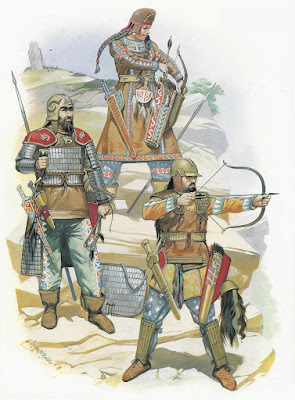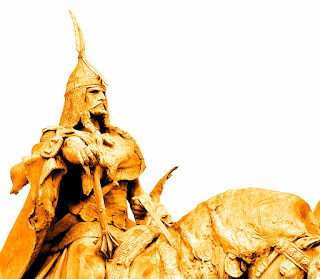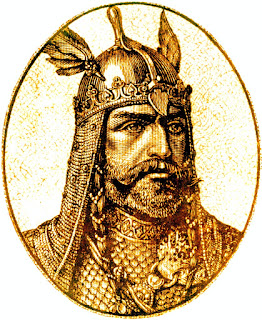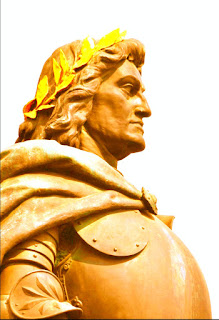I have seen an ancient path, an ancient trail, traveled by the rightly enlightened ones of the past. Following it, I traveled and explored the blissful, fruitful, and widespread path.
– Buddha

The non-dogmatic Inner Path tradition can be traced back in a broader sense to a very distant past – a time so ancient that we can’t express it in years or numbers. For example, Tönpa Shenrab Buddha, who lived and taught in Central Asia 19,000 years ago, is part of this tradition, which is still alive today in Tibet and is known as Bön. However, there is a closer lineage that begins with the Enlightened One, the Buddha, who was a Scythian prince and later became Enlightened, born 2,500 years ago in Northern India.
However, the present world system is not the first; there were other world systems before, and Enlightened beings lived in them as well, passing on their knowledge. In this broader sense, the non-dogmatic Inner Path tradition can be traced back to beginningless times, to a primordial knowledge that is timeless and transcends the concepts of space and time. The non-dogmatic Inner Path tradition is passed down through generations in a living lineage and has slowly evolved into a lush, vast tree, reaching us. Its branches now spread all over the world.
The Living Lineage Has its own Internal Spiritual Power
The living tradition has its own internal spiritual power. We call this the blessing of the tradition. One who receives the blessing of the tradition in the transmission process somehow connects to this power. Using an everyday example, we can liken the power of the living tradition to electricity, to which we can connect, for instance, a computer, allowing it to draw the power needed to function. The non-dogmatic Inner Path draws its strength from the living tradition. Living, practicing tradition here refers to that in which the vivid experiencing of the recognizable fullness of the present living moment has descended in an unbroken line since the ancient enlightened masters up to the present day, to today’s living teachers. Every living, enlightened master of today in the tradition received the transmission from a living person, their own master, in such a way that, through the master’s guidance, advice, and help, and through their diligent work, they experienced the indescribable, ultimate awakening. This recognition, of course, cannot be transmitted, but someone can be guided to it using skillful methods. In the moment of recognition, the minds of the master and the disciple meet, becoming inseparable, merging into one. This is the moment of transmission.
Transmission is nothing other than experiencing the fullness of the present moment – the meeting of the two minds in the experience of the true nature of reality. Transmission has occurred in an unbroken continuum from the masters of ancient times to the present day. This is what we call the essential tradition of the Inner Path. Typically, transmission is preceded by many years of work – during which the disciple learns and practices under the personal guidance of the master.
On the Inner Path, every aspect of practice – including the arts, sciences, everyday activities, and more – is connected to the living lineage, as we inherit the power through the living lineage that can make every moment of our lives part of our inner journey. The core tradition of the Inner Path, its main artery, is the tradition of meditative experience – the practice of vividly experiencing the present moment through spiritual practices.
Living in the Now – Connecting the Past and the Present
Living in the present moment is a bridge between the wisdom of the past and our current reality. Initially, we are attached to our parents emotionally, but as we mature, we become independent individuals. This individuality must then evolve into a transition towards a sense of human community. Valuing our everyday home life is crucial, and respecting family traditions connects us to the richness of the world. Appreciating the wisdom of our ancestors and experiencing the ‘now’ connects us to our roots while paving the way for an enlightened society. Upholding the ‘now’ is vital to prevent corruption and build a foundation for an authentic human community. We must live in the ‘now,’ appreciating reality, as it forms the essence of an enlightened society and allows us to overcome worldly challenges.
Respect for Ancestors – Living in the “now”
In various societies, people establish shrines to honor their ancestors. Japan, a highly developed modern society, still strongly upholds ancestor reverence today. Some may view this reverence as a superstitious manifestation of primitive thinking, but in reality, it signifies honoring the accumulated wisdom within one’s own culture. It’s vital to appreciate the wisdom gathered by people over millennia, acknowledging the achievements and knowledge handed down by our ancestors, which laid the foundation for our lives. However, solely revering the past won’t solve current world issues; we must establish a connection between our traditions and present life.
The magic of the present moment is the bridge that connects the wisdom of the past to our current reality. Regardless of when a work of art was created, when we appreciate its beauty, we experience the same ‘now’ in which it was brought into existence. Embracing the sacredness of the ‘now’ involves being consciously aware of where we are and what we are doing. The family environment and our everyday lives are crucial for experiencing the ‘now.’ Seeing our home as a sacred place offers an opportunity to experience the present fully.
To create an enlightened society, being present in the ‘now’ is fundamental. It’s about experiencing the true ‘now,’ and seeking it elsewhere will lead to confusion. The great eras of history, marked by progress and peace, happened in the ‘now.’ Respecting the present and maintaining a connection with our traditions and culture is essential to prevent corruption and distortion. This is the foundation for an enlightened society. We must learn to live on Earth as it truly is, appreciating the reality and embracing the ‘now’ in every aspect of life.
We Live on This Earth, the Real Earth
When corruption infiltrates a civilization, it’s because that civilization is no longer in the now, but has become past and future. The great eras of history, marked by great art, progress in knowledge, or the spread of peace, were all in the now. People who walked the Inner Path were active and able to live and create in the now. Those situations all happened in the sacred moment of their now.
We must uphold the now, so as not to further corruption, not to distort the now, and not to have any false synonyms for it. The perspective of an enlightened society is that tradition, culture, wisdom, and dignity can be experienced in the now, and everyone maintains the now. This way, no corruption can occur. An enlightened society must have a good foundation. The now of your home is this foundation. You can move forward from here. By seeing your home as sacred, you can enter domestic situations with awareness and joy, rather than feeling overwhelmed. Washing dishes and cooking may seem entirely worldly activities, but if we apply awareness, we train our entire being to open up even more in any situation, without fear that our existence will narrow down.
People often think that to solve the world’s problems, we need to subdue the Earth, not touch the earth, not touch the foundation. A definition of corruption is: attempting to subdue the Earth to cover up reality. We are flooded with various scented deodorants, so we cannot smell the scent of reality, and with all sorts of processed foods, so we do not taste the raw ingredients. The perspective of the Inner Path does not try to create a dream world where no one has to see blood or experience nightmares. The perspective of the Inner Path is based on the understanding that we live on this Earth, the real Earth, the Earth that yields crops, the Earth that provides sustenance. We can learn to live on this Earth: how to set up camp, pitch a tent, ride a horse, milk a cow, make a fire. Even if we live in a city, in the twentieth century, we can learn to experience the sacredness, the now, the reality. This is the foundation for creating an enlightened society.
The Tradition of Wisdom and Gentleness in Warriorhood
The essence of warrior behavior, or the essence of human courage, is to never give up, never give up on anyone or anything.
In today’s world, humanity is facing perhaps deeper problems than ever before. The current state of the world worries us all: the wars raging in many places, environmental pollution, ecological imbalance, widespread poverty and economic instability, social and political turmoil – the world is like a disturbed beehive. Therefore, it is increasingly important to find simple, direct, and easily applicable ways to work on ourselves and share our knowledge with others.
The teachings of the Inner Path are based on the idea that there is a wisdom, a power inherent in humans that can help solve the problems of our Earth. This wisdom and power do not belong to a selected species, culture, or religion. On the contrary, it is the warrior tradition of all humanity, which has existed in various cultures throughout our history.

Being a warrior does not mean waging war against someone else. Violence is the source of problems, not the solution. The word “warrior” here means a brave, fearless individual. The warrior tradition of wisdom was embodied, among others, by Japanese samurais, Native Americans, and the knights of King Arthur. Hungarians, in particular, have a powerful warrior tradition dating back to ancient times: we are descendants of the Scythian, Hun, and Hungarian warriors who earned the respect and admiration of everyone. This tradition was continued by our great knight-kings – Atila, Árpád, Saint Ladislaus, the Hunyadis – defenders of our strongholds, the kuruc rebels, the world-famous Hungarian hussars, and many more. Their blood flows in our veins, carrying with it the Scythian virtus.



